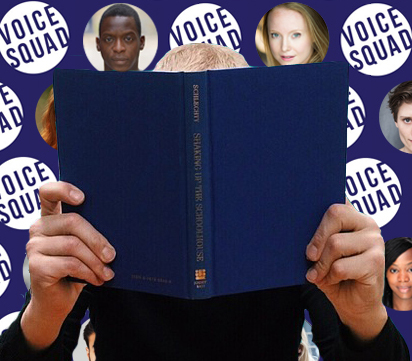Once upon a time an audiobook narrator sat down at a microphone and began to tell a story. But how had they come to be there? And what adventures were going to happen next?
Here at Voice Squad, we love audiobooks of all types! In fact, back in November our Willow Nash wrote a fantastic article on The Importance of Audiobooks for Children. As we are booking more and more audiobook recordings, we wanted to delve deeper into this fascinating world.
If you’ve ever listened to an audiobook, you may have wondered about the audiobook narrator speaking into your ear. Perhaps you’ve even imagined them sitting in the studio or wondered how they created their character voices.
It can certainly be a tricky job for a voice artist. The task requires a cocktail of acting and technical skills, with a healthy dose of stamina. A single voice has to take a listener away from their mundane tasks and into a whole new world.
So what exactly is involved in the process?
Fortunately we have a wide range of voices on hand to answer that very question! Our Amy Enticknap and Rachael Louise Miller were delighted to give us the lowdown on everything audiobook related.
Audiobook Narrator Q&A
So what do you enjoy most about recording audiobooks?
RLM: I love storytelling, I think it can be absolutely magical and getting to interpret someone else's tale is really interesting. You get to completely immerse yourself in their world.
AE: Getting in to the world of the book, as well as being able to voice characters which, in a theatre job, I would never get cast as.
How do you prepare before an audiobook recording?
AE: I read the book from cover to cover so I know where the plot is going, and work out which accents and voices I am going to use for all the characters.
RLM: Well for starters, read the book, ha! As I'm reading, I mark up all the bits of dialogue and make notes about each character as they're introduced and think about what sort of voice you can do for each one.
What’s the process of recording an audiobook like?
RLM: It can be really hard, both for you and the producer, as it requires a lot of concentration. However if it's a book you're both really enjoying, perhaps one you would have ordinarily read for pleasure, then it can be really fun.
AE: It’s hard work but fun!
What is the most challenging aspect of being an audiobook narrator?
AE: Maintaining an efficient level of concentration over the day/week and keeping the vocal chords well lubricated!
RLM: The range of characters and accents within a book can be very challenging. For example, I've narrated a series where the protagonist travels to a different country in each book, meeting people of different nationalities. Equally, when you have a group of characters all around the same age and from the same place, it can be hard to find ways to differentiate between them.
How does recording an audiobook for children differ from adult books?
AE: I’ve done more children’s books than adult ones: my default casting seems to be 10-year-olds or witches for children’s books, which I love! There tends to be more scope for having fun with the voices of characters and animals/sound effects. There are also (often) pictures to aid your characterisations too, which are useful and provide extra entertainment in the studio!
RLM: Generally, if it's a book for a younger audience, the protagonist will be younger, so I'd use a different vocal register and perhaps more energy in the performance. I actually enjoy doing children's books more than any other genre, as I think it suits my vocal style more.
To listen to Amy and Rachael in action, you can listen to their audiobook reels below.
We hope this has given you some insight into what it takes to be an audiobook narrator, though every artist will have their own experience. But how does the story end? What happens once the recording’s finished and the artist has left the studio?
With the recording over, the job becomes a technical one. The engineer has to remove the clicks, breaths, and other sounds that are a natural side-effect of reading aloud. Then, once it’s edited, the audiobook can be published.
Once it’s available to buy, people all over the world can listen to the artist while they walk, drive, commute and work.
And surely that’s a very happy ending!


